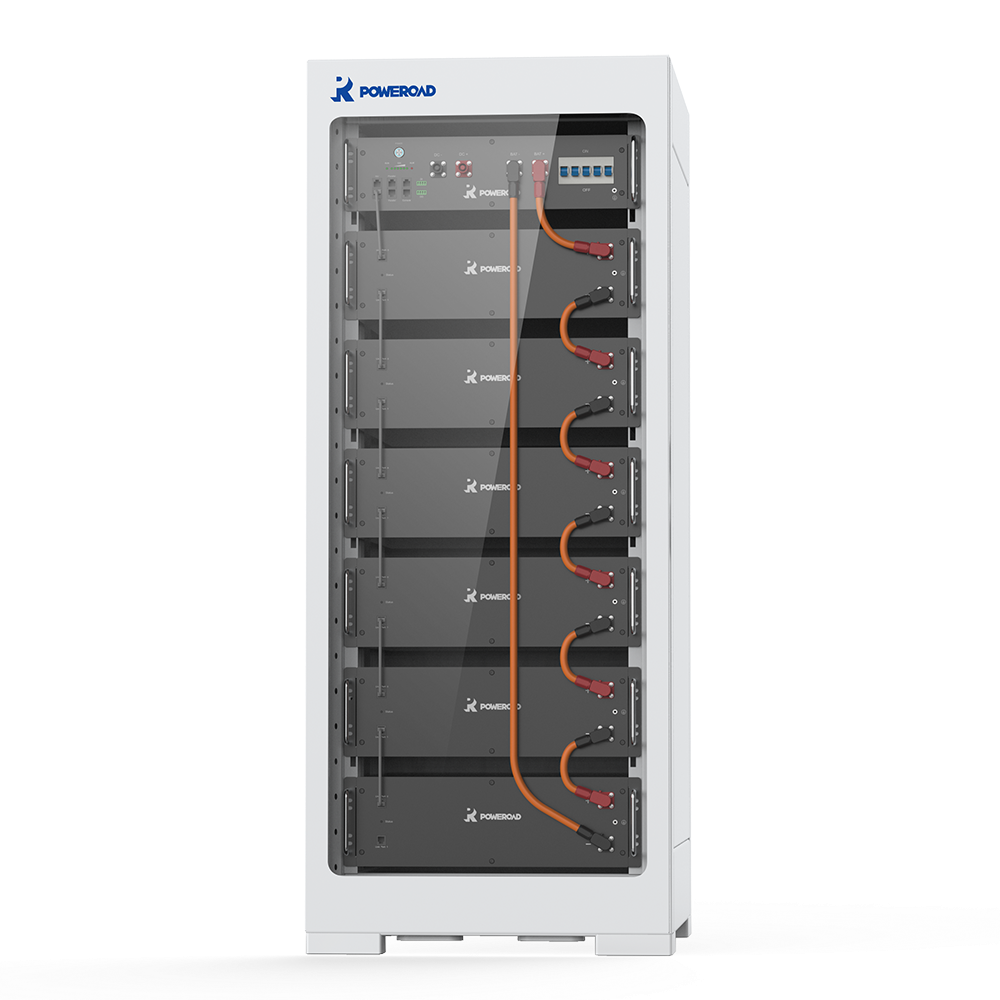

POWEROAD H-U51100 51.2V 100Ah racking residential LiFePO4 battery energy storage system with built-in own-developed BMS.
● Scalable from 5.32kWh to 63.90kWh power configurations.
● Modular design allows convenient installation, saving labor cost.
● Extendable-modular, adding more capacities as needed.
● Safest LiFePO4 technology, sustained power supply.
● Long lifespan, up to 8000 cycles.
● Armed with POWEROAD designed BMS, three layer over current
● protection, safety first.
● Floor space sparing, allowing more space management.
● RS485, CAN communication support. Wi-Fi / BLE optional.
● Series connection providing higher efficiency and larger power.
The META H1 is powered by lithium-ion phosphate (LiFePO4) battery and for use with an external inverter.
Given the credit to the POWEROAD BMS, the systems will automatically trigger four layer over-current protection ensure powerful output and safety.
Starting with 1 module of 102.4V 52Ah batteries, users can configure the system capacity according to requirement from 5.32kWh to 63.90kWh by quick installation.

Key Features
Qualified Cell Selection:
We offer the best selections, giving you a wide range of choices of battery cells including CATL, CALB, EVE, and etc. All battery cells are UL1642/IEC62133/IEC62619 Qualified. You make the decision, and we handle the rest.
High Efficiency Components:
POWEROAD ONLY applies the top-tier conductors to the battery products, giving one of the best guarantees to reduce the resistance and boosts the performance.
Trusty Production:
POWEROAD has passed the major global manufacture certifications, we promise our customers a professional and rigorous production standard operation procedure, ensuring the build process is scientific and the build quality is solid.
Rigorous Inspection:
POWEROAD has over 20 steps of inspections that covering before, during, and after the production, we deliver one of the most rigorous inspection SOP in the industry, assuring the product quality, improving the customer experience.
| Technical Spec | |
| Battery Type | LiFePO4 |
| Nominal Voltage (V) | 51.2 |
| Battery Capacity (Ah) | 102 |
| Nominal Energy (Wh) | 5220 |
| Cycle Life | 8000 |
| Charge Voltage (V) | 57.6 |
| Discharge Voltage (V) | 43.2 |
| Recommend Charge/Discharge Current (A) | 50 |
| Max. Charge/Discharge Current (A) | 100 |
| Peak Charge/Discharge Current (A) | 150 |
| Configuration (Max. in 1 Battery Group, pcs) | 15 |
| Mechanical Spec | |
| Dimension (mm) | 442*450*145 |
| Weight (Kg) | 44 |
| Communication | RS485, CAN |
| Protection Class | IP20 |
| Cooling Type | Natural cooling |
| Working Temperature (℃) | Charge: 0~50 |
| Discharge: -10~50 | |
| Humidity | 5% ~ 85%(RH) Without condensation |
| Certification | CE, UN38.3 |
In our ever-evolving world, the pursuit of sustainable energy solutions has become paramount. As we strive to reduce our carbon footprint and transition to cleaner energy sources, innovations in energy storage technologies are playing a pivotal role. One such innovation is the residential lifepo4 battery, a cutting-edge advancement that promises to revolutionize how we store and utilize energy in residential settings.
In this comprehensive article, we will delve deep into the world of LiFePO4 batteries, exploring their composition, benefits, applications, and the significant impact they are making on the residential energy storage landscape. As we embark on this journey, we will uncover how LiFePO4 batteries are at the forefront of sustainable living, ensuring a greener and more efficient future for homeowners worldwide.
1.1. What Are LiFePO4 Batteries?
LiFePO4 batteries, short for Lithium Iron Phosphate batteries, belong to the family of lithium-ion batteries and are renowned for their exceptional energy density, longevity, and safety features. Unlike traditional lead-acid batteries, residential lifepo4 battery use lithium iron phosphate as their cathode material, making them a preferred choice for energy storage applications.
1.2. Composition of LiFePO4 Batteries
LiFePO4 batteries consist of several key components:
1.3. Advantages of Residential Lifepo4 Battery
LiFePO4 batteries offer numerous advantages, making them an ideal choice for residential energy storage:
2.1. Off-Grid Solar Systems
One of the primary applications of residential lifepo4 battery is in off-grid solar systems. These batteries store excess solar energy generated during the day for use during the night or on cloudy days. Homeowners can significantly reduce their reliance on grid electricity and enjoy a consistent and renewable power source.
2.2. Energy Backup
LiFePO4 batteries serve as reliable backup power sources during grid outages. They seamlessly switch to battery power when the grid fails, ensuring that essential appliances and systems continue to operate, providing peace of mind to homeowners.
2.3. Peak Shaving and Load Management
Residential lifepo4 battery can be used to manage peak electricity demand effectively. During periods of high electricity usage, these batteries discharge stored energy, reducing the load on the grid and helping homeowners avoid peak-hour energy costs.
2.4. Time-of-Use (TOU) Optimization
LiFePO4 batteries can be programmed to charge during off-peak hours when electricity rates are lower and discharge during peak hours when rates are higher. This smart energy management reduces electricity bills and enhances cost-effectiveness.
3.1. Reduced Carbon Footprint
By enabling the efficient storage of renewable energy, residential lifepo4 battery play a pivotal role in reducing carbon emissions. Homeowners who utilize solar panels and LiFePO4 batteries can significantly decrease their reliance on fossil fuels for electricity, contributing to a greener planet.
3.2. Resource Efficiency
LiFePO4 batteries are highly resource-efficient, thanks to their long lifespan and recyclability. The reduction in battery replacements and the ability to recycle lithium and iron phosphate materials make them a sustainable choice for residential energy storage.
3.3. Energy Independence
With residential lifepo4 battery, homeowners can become more energy independent by generating and storing their electricity. This reduces their reliance on centralized power grids and fosters a sense of energy autonomy.
4.1. Cost
While residential lifepo4 battery offer numerous benefits, they can be relatively expensive upfront. However, the long-term savings from reduced energy bills, longer lifespan, and reduced maintenance costs often outweigh the initial investment.
4.2. Limited Energy Density
LiFePO4 batteries have a lower energy density compared to some other lithium-ion battery chemistries. This limitation may require larger battery systems to meet the energy storage needs of larger households.
4.3. Recycling Infrastructure
To maximize the sustainability of residential lifepo4 battery, it is crucial to develop efficient recycling infrastructure to recover valuable materials and minimize waste. Governments and industries should invest in battery recycling facilities to address this challenge.
5.1. Technological Advancements
Continuous research and development in battery technology are driving improvements in residential lifepo4 battery. Future advancements may lead to even longer lifespans, increased energy density, and lower costs.
5.2. Integration with Smart Home Systems
Resident LiFePO4 Batteries are increasingly being integrated into smart home systems, allowing homeowners to monitor and control their energy consumption and storage remotely through smartphone apps and home automation platforms.
5.3. Market Growth
The global market for residential residential lifepo4 battery is expected to grow substantially in the coming years as more homeowners embrace sustainable energy solutions. This growth will likely lead to increased competition and further innovations in the field.
The residential lifepo4 battery is a game-changing technology that is transforming residential energy storage. Its numerous advantages, including long lifespan, safety, and environmental benefits, make it a compelling choice for homeowners looking to reduce their carbon footprint and gain energy independence.
As we move toward a more sustainable future, LiFePO4 batteries are poised to play a vital role in reshaping the residential energy landscape. With ongoing advancements and increasing market adoption, these batteries are set to power a greener, more efficient, and environmentally responsible world for generations to come.

Visit us
Email Us
Navigation
QR Code
